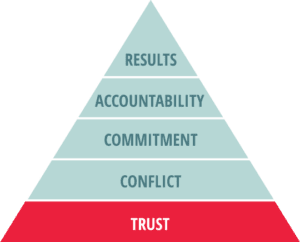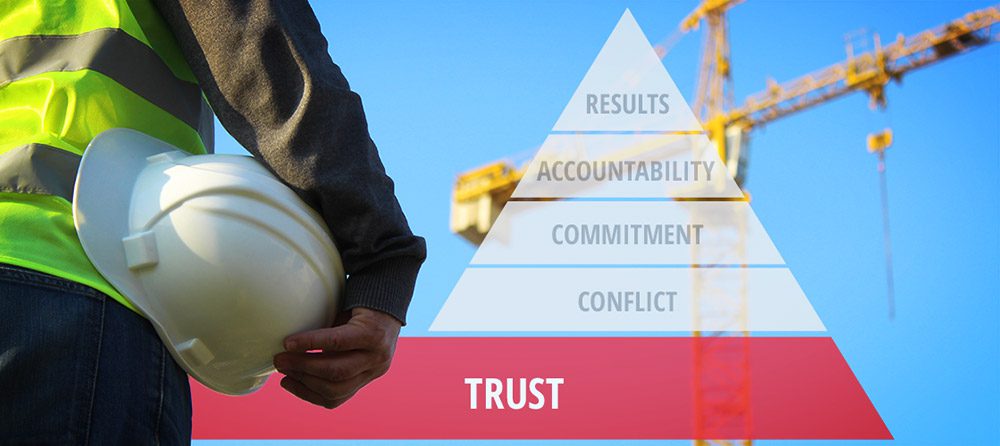Patrick Lencioni’s Five Behaviors of a Cohesive Team refers to the Pyramid of Truth. The foundation of the pyramid is trust. According to Patrick, “trust is about vulnerability. Team members who trust one another and learn to be comfortable being open, even when exposing their failures, weakness, or fears, build vulnerability-based trust. Vulnerability-based trust is where members of the team are open with one another—ready to disclose their thoughts and feelings, share ideas, admit their own shortfalls and mistakes, ask for help, and give and receive honest feedback.”
 Vulnerability is the ability to ask for what you need, be willing to expose your feelings, communicate what you want, express what you think, and be in the present moment. The root word of vulnerability is vulnerá which means to wound. Developing vulnerability requires you to be strong enough to potentially hurt from another’s feedback to engage in healthy conflict, the next step in Lencioni’s Pyramid towards results. Four steps you can take to develop vulnerability in the workplace are:
Vulnerability is the ability to ask for what you need, be willing to expose your feelings, communicate what you want, express what you think, and be in the present moment. The root word of vulnerability is vulnerá which means to wound. Developing vulnerability requires you to be strong enough to potentially hurt from another’s feedback to engage in healthy conflict, the next step in Lencioni’s Pyramid towards results. Four steps you can take to develop vulnerability in the workplace are:
1. Be bold enough to ask for help and/or feedback from others whether you think you need it or not.
“To share your weakness is to make yourself vulnerable; to make yourself vulnerable is to show your strength.” (Author and philosopher Criss Jami)
2. Be bold enough to offer help and give feedback if you know it will improve results.
G—Given with permission (ask the person if you could give them feedback)
I—Intent for growth (not self-serving)
F—For the person (do not make it a personal attack)
T—Targeted for success (the success of the project, team, company)
3. Process emotion with communication.
“Every thought, feeling, and emotion creates a molecule known as a neuropeptide. Neuropeptides travel throughout your body and hook into receptor sites of cells and neurons. Your brain takes in the information, converts it into chemicals, and lets your whole body know if there’s trouble in the world or cause for celebration. Your body is directly influenced as these molecules course through the bloodstream, delivering the energetic effect of whatever your brain is thinking and feeling.” (Deepak Chopra)
Depending on someone’s communication style and learned ability to process these emotions, you can see tears or other emotions that are not necessarily good or bad but are processing what was said, how it was said.
4. Be able to sincerely apologize.
In marriage, they say never go to bed mad at each other because things will escalate in the morning. In business, if you should have handled a situation differently, be bold enough to say so. Apologizing for how it came across does not mean you are changing the message or your stance on a situation. It just means you value that person—you have respect for them and did not intend to hurt them. You then need to let it go, as that person will have a choice to sincerely reciprocate or not. You will never reach the core of the pyramid of trust—commitment—if you can’t be vulnerable to come to terms.
“To love at all is to be vulnerable. Love anything, and your heart will be wrung and possibly broken. If you want to make sure of keeping it intact, you must give it to no one, not even an animal. Wrap it carefully round with hobbies and little luxuries; avoid all entanglements. Lock it up safe in the casket or coffin of your selfishness. But in that casket, safe, dark, motionless, airless, it will change. It will not be broken; it will become unbreakable, impenetrable, irredeemable. To love is to be vulnerable.” (C.S. Lewis, The Four Loves)
Although the construction industry has moved from a communication style of “command and control” to a more charismatic form of communication for most, the tendency to want to control people and situations still exists. When checking references, there is no better compliment for a candidate than when a co-worker says a strength of theirs is they can be tough but admit when they were wrong.
Trust vs. Vulnerability-Based Trust
Trust is the belief in the reliability and truth of someone or something, but vulnerability-based trust goes deeper than that. According to Patrick Lencioni, vulnerability-based trust occurs when leaders “comfortably and quickly acknowledge, without provocation, their mistakes, weaknesses, failures, and needs for help. They also recognize the strengths of others, even when those strengths exceed their own.” This deeper level of trust is a necessary component for a team to achieve its goals because “team members have to learn to trust each other if they’re going to be a real team.”
To boldness through truth and understanding of yourself and others,
Suzanne Breistol




